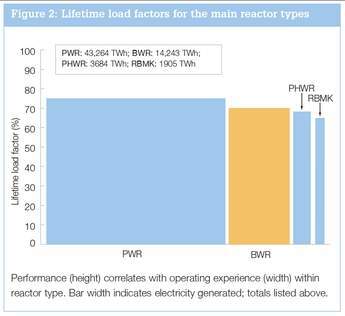Data were available for 400 nuclear units with over a year’s operating experience as of 30 June 2012. They comprised 256 pressurized water reactors (including 48 of Russian design, also known as VVERs), 84 boiling water reactors, 46 pressurized heavy water reactors, 11 RBMK reactors, two magnox reactors and one fast breeder reactor (Russia’s BN-800 at Beloyarsk).

The overall average load factor for these units for the 12 months to 30 June was 72.4%. Their average load factor for the first half of 2012 was only slightly lower at 71.5%. Average load factors for each reactor design for the first half of 2012 are plotted in Figure 1, below. As can be seen in the graph PWR reactor performance has remained steady, averaging between 80 and 83% for the last decade or so. The figure for 2012, so far, is lower than this; 74.5%, likely affected by the PWR units that remain offline in Japan. Other reactor designs have experienced much more fluctuation in their load factors, however; on the whole and ignoring the recent blips for LWRs, performance has been improving.

Figure 3: Annual and lifetime load factors by type

Figure 5: Year-on-year comparison of annual factors by type
The average lifetime load factor for all units, 73.0%, represents more than 8000 effective full power years of operation for the units totalling 374 GW of nuclear capacity listed in our tables.
Looking at Table 2, we see that six of the 11 units that achieved a load factor of over 100% in the period from 1 July 2011 to 30 June 2012 are located in the USA. The list also include two Russian units (Balakovo 2 and Rostov 1), Chinshan 2 in Taiwan, Yonggwang 3 in South Korea and a relatively new entry Rajasthan 6 of India, which has been in operation for just 27 months. Japanese units are notably missing from this list. For the equivalent period ending June 2011, and before the impact of Fukushima had set in on operating plants, Table 2 was topped by Takahama 4 (load factor 105.6%), joined by four other Japanese units with capacity factors greater than 100%.

Figure 4: Lifetime load factor averages by country
Other things to note this quarter are two new entries in Table 2. Chasma (Pakistan) and Ling Ao 4 (China) both join the main table this time, highlighted in green. It is the last time we will see Wylfa 2 in this table (highlighted red), as that UK unit stopped in April. This leaves just sister unit Wylfa 1 as the only magnox reactor operating in the world.
Author Info:
This article first appeared in the November 2012 issue of Nuclear Engineering International magazine.
Related ArticlesSmall, but not forgotten
